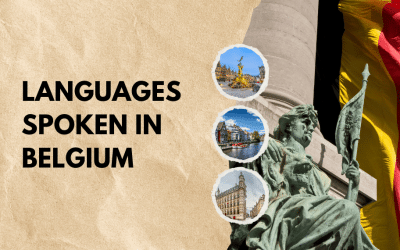Translation is among the most rapidly developing fields in the world. Driven by huge technological advances, translation services are now becoming faster and more reliable.
Translation services are nowadays essential for overcoming cultural and linguistic boundaries in many domains. What’s more, in recent years, translation has reshaped the way we communicate by bringing our huge world closer together.
In this blog, we’re embarking on a journey through the most recent developments in the ever-evolving field of translation technology.
From the recent improvements in the integration of artificial intelligence to the newest advancements in cloud-based platforms, we’ll explore how these innovations are revolutionizing the translation industry.
Keep reading, because we’ll also consider some of the challenges and ethical questions that these new advancements pose.
Are you Looking for professional translation services?
Milestone helps you accurately translate your documents, websites, apps, videos, and more in 70+ languages.
Emerging trends in translation technology
Emerging trends in translation technology are reshaping how we overcome language and cultural barriers.
In recent decades, Artificial Intelligence (AI) and machine learning (ML) have played pivotal roles in enhancing the accuracy and efficiency of translation tools. AI agent software, utilizing advanced NLP algorithms, has further optimized these tools, making translations faster and more precise.
Neural machine translation is yet another technology that has revolutionized the industry by enabling more nuanced and context-aware language processing.
But these are only a few examples, and as you’ll read in the following section, translation technology continues to evolve.
Neural Machine Translation
One of the most recent trends in NMT includes the refinement of transformer-based models.
These models have an additional attention layer, which increases accuracy. This added attention mechanism allows the model to pay closer attention to specific parts of the sentence during the translation process. In this way, the output becomes more accurate.

Also read: A Comprehensive Guide To Machine Translation Post-Editing
Recent advancements in natural language processing have led to the development of cross-lingual pre-training for NMT systems. This new technology is showing promising results in improving the translation system’s performance.
What’s more, considerable efforts have been directed towards simplifying the training process of NMT models by reducing the requirements. This in turn would be a key advancement since it would allow NMT models to be trained for less widely spoken languages (also called low-resource languages due to the limited data available for training the NMT models).
Natural Language Processing and Sentiment Analysis
The most recent developments in Natural Language Processing (NLP) and Sentiment Analysis are particularly related to improvements in contextual understanding and fine-grained analysis of language models.
For instance, transformer-based language models, such as GPT-3 and BERT, have showcased an improvement in pre-trained representations that capture intricate linguistic nuances.

Advances in transfer learning techniques allow models, that have been trained to execute one task to be adapted efficiently to another. Such models are based on sentiment analysis models and focus on learning from diverse data sources.
There is also a huge emphasis on multimodal sentiment analysis, which integrates textual and visual cues. This technology aims to provide the models with a more comprehensive understanding of sentiment.
Also read: Natural Language vs. Constructed Language vs. Artificial Languages
Cloud-based translation platforms
Cloud-based translation platforms have been gaining traction in recent times, particularly regarding collaboration, scalability, and accessibility. These platforms have changed the translation world by allowing for a more seamless and centralized translation process regardless of users’ location, task, etc.
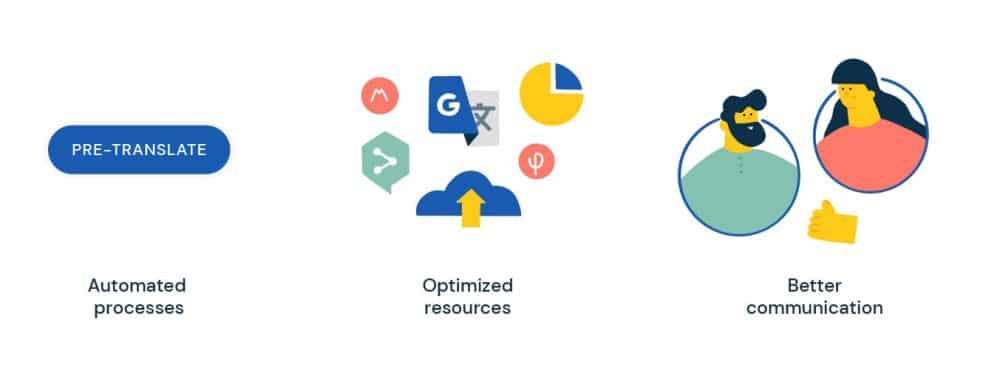
Also read: Translation Memory: Everything You Need To Know
By leveraging cloud technologies, many platforms now offer real-time collaboration features. These features allow multiple users to work on translations simultaneously.
Scalability is another key focus regarding cloud-based translation platforms to enable these platforms to handle large volumes of translation tasks more efficiently.
Additionally, advancements in cloud infrastructure have resulted in improved processing speeds. This in turn reduces the time needed for the delivery of translation projects.
One of the best improvements is the integration of enhanced security features and compliance measures. Thus, these platforms are now more reliable regarding data privacy and regulatory requirements.
Cloud cost optimization further supports this reliability by ensuring that businesses can sustain secure, compliant platforms without overspending, balancing performance with cost-efficiency
Speech translation (automatic speech recognition, text-to-speech)
Recent developments in speech translation, related to automatic speech recognition (ASR) and text-to-speech (TTS), have led to improvements in accuracy, naturalness, and multilingual capabilities.
The newest ASR systems are now powered by deep learning architectures, which in turn have optimized the accuracy of the systems. They are now able to transcribe more accurately spoken language across various languages and even accents.
![]()
Also read: How to Localize Your App and Reach New Users
In addition, the integration of neural TTS models has led to more naturally sounding and expressive synthetic speech. In other words, machine-generated speech is now sounding even more like human speech.
Multimodal approaches, combining visual and contextual cues with speech data, are promising in enhancing the overall accuracy and context-awareness of speech translation systems.
Real-time speech translation
Real-time speech translation is another feature that is being closely investigated to improve the existing real-time speech translation technology.
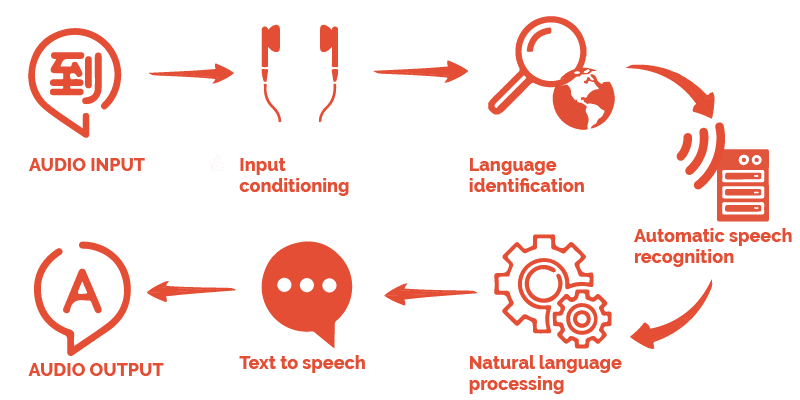
Also read: Speech Transcription for AI: Why We Still Need Humans
Recent innovations in machine learning, natural language processing, and neural network architectures have been central to improving the accuracy of real-time speech translation systems.
Researchers have been leveraging neural machine translation models to reduce latency and enhance the accuracy of the output of these systems.
Additionally, the integration of advanced speech recognition algorithms has greatly contributed to a better understanding of spoken language. This, in turn, has enhanced the accuracy and context-awareness of the translation systems.

Furthermore, new developments in cloud-based translation systems have made it possible to utilize real-time speech translation across different devices.
Needless to say, continuous research in this field would further improve this technology, making real-time speech translation even more efficient and accurate.
Also read: Top 10 Subtitling Companies: How To Choose The Right One
Connect With Your Non-English Speaking Audience in their native languages
Milestone helps you accurately translate your documents, websites, apps, videos, and more in 70+ languages.
Augmented reality (AR) and Virtual Reality (VR)
Recent developments in Augmented Reality (AR) and Virtual Reality (VR) have been integrated into translation technology as well.
AR, for instance, is currently being utilized to overlay real-world objects with translated text or subtitles. This, in turn, would aid users in understanding foreign languages in their immediate surroundings.
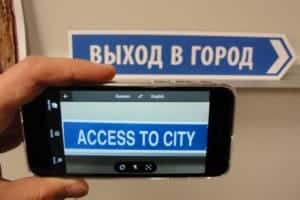
Additionally, AR and VR are being employed as tools for real-time translation during virtual meetings or conferences.
AR and VR advancements are integral to the translation industry, contributing greatly to more interactive and accessible interlingual communication regardless of location and language.
Also read: Are Translation APIs & Connectors Right Choice For Your Business?
Blockchain technology in translation
In translation, blockchain technology integrates decentralized and secure distributed ledgers to improve various aspects of the translation process.
For example, blockchain technologies are often integrated to ensure the authenticity and accuracy of the translated content. By storing previous translations on a blockchain, the files become more resistant to unauthorized changes. In this way, blockchain can provide a more transparent and verifiable translation history of every project.
In this regard, blockchain technology can be beneficial to resolving copyright and intellectual property issues by offering secure, traceable management of ownership and usage rights for translated content.

Smart Contacts is another recent development in blockchain technology that can be widely utilized in the translation industry. Smart contacts would allow for automated translation agreements, thus, ensuring fair compensation and timely delivery of translation projects.
Additionally, blockchain can be leveraged to create decentralized translation marketplaces. In other words, blockchain technology would allow translators to connect directly with clients
without any necessity for intermediaries. This fosters a more transparent and efficient translation process.
Ethical Considerations and Challenges in Translation Technology
Ethical considerations and challenges in translation technology are gaining prominence as the field evolves. The newest technological advancements, however, might offer many solutions to problems that have been around for a while, but they also open up the discussion for several other ethical concerns.
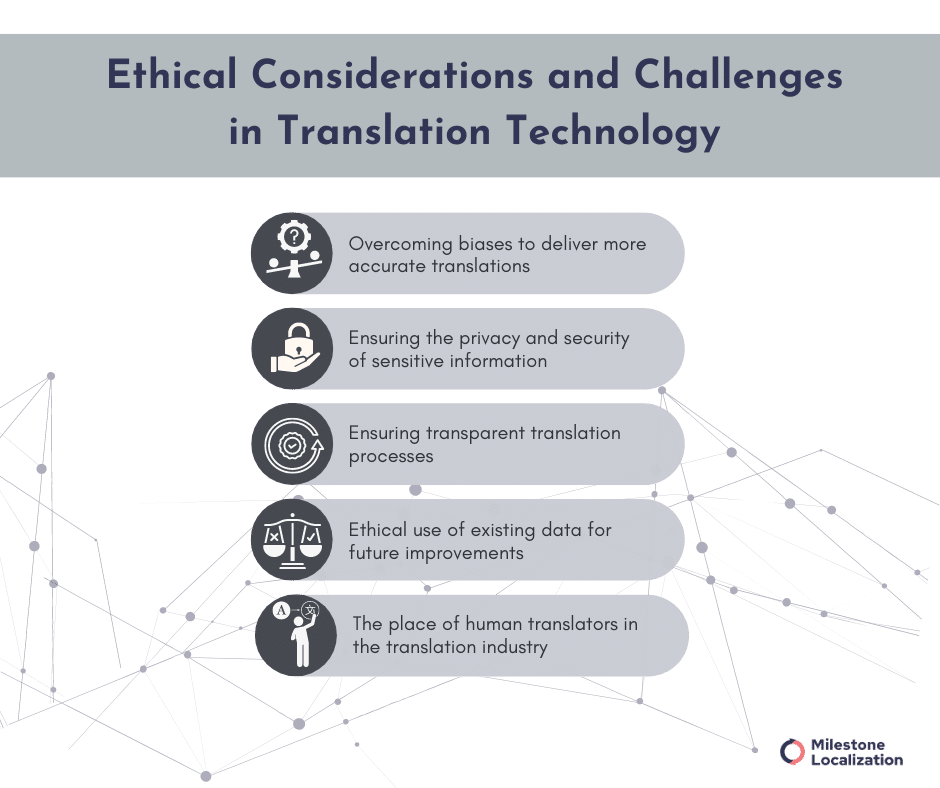
Overcoming biases to deliver more accurate translations
With the increasing use of advanced technologies like machine translation and artificial intelligence, concerns about bias, accuracy, and cultural sensitivity come to the foreground.
For instance, MT systems often associate certain genders with certain professions, personal traits, or adjectives.
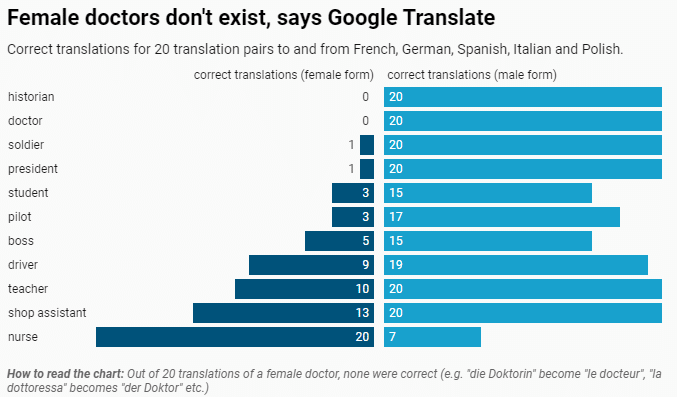
Also read: Pros & Cons Of Using Google Translate For Business
When translating from gender-neutral language, or languages that do not have pronouns for female and male genders, translation systems tend to produce biased output.
As a result, you can see translations, such as this one from Hungarian (a gender-neutral language), into English:

New models offer improvements in the existing systems, allowing them to pay closer attention to little details related to accuracy and cultural nuance. But we need to keep in mind that this technology is pretty new and thus needs to be improved even more.
Needless to say, the current technology available has a long way to go before surpassing human abilities to detect culture- or context-related errors.
Ensuring the privacy and security of sensitive information
Privacy has been an issue for the translation industry for a long time.
With the rise of cloud-based translation platforms, the security of sensitive information has become a growing ethical concern.
Fortunately, advancements in the technology of these platforms offer promising solutions to keeping clients’ data protected.
To further enhance connection security, especially when working remotely, many professionals rely on VPN for Windows to ensure data stays encrypted and private.
Ensuring transparent translation processes
Highly automated translation processes may offer optimized workflows and reduced translation costs, but they also might lead to reinforcing language inequalities and stereotypes.
As more languages and dialects are incorporated into translation models, it might be hard to understand what decisions the technologies are making when producing translations.
Thus, issues related to transparency and accountability must be taken into account and improved.
Ethical use of existing data for future improvements
The integration of NLP in translation technology has been a real success for the industry. However, these translation models are highly dependable on data for their improvement.
Therefore, considerations regarding the ethical use of user data as well as informed consent have become central to the industry.
The place of human translators in the translation industry
Human translators have been left out of the spotlight due to the massive developments in translation technology.
This, in turn, has raised fears about the impact of technology on employment in the translation industry.
However, it should be pointed out that, despite all the advancements in translation technologies, human translators are still an integral part of the translation process.
Several ethical concerns and issues have surfaced due to the advancements in translation technology. Thus, finding a balance between innovation and ethical research practices is imperative for the more reliable and sustainable advancement of translation technology.
Also read: App Localization Strategy Report: Where and How to Expand for Global Success
In conclusion…
Translation technology has undergone several improvements in recent years, and as it seems, new advancements are constantly being made.
While these emerging trends offer solutions to old, well-known problems, we need to keep in mind that innovation takes time, and there are certain ethical considerations one should reflect on.
Indeed, innovations happen through trial and error, so we need to be patient.
Until then, however, we can always rely on the expertise of human translators as well as existing technology.
Are You Looking for professionals translation services?
Milestone helps you accurately translate your documents, websites, apps, videos, and more in 70+ languages.



